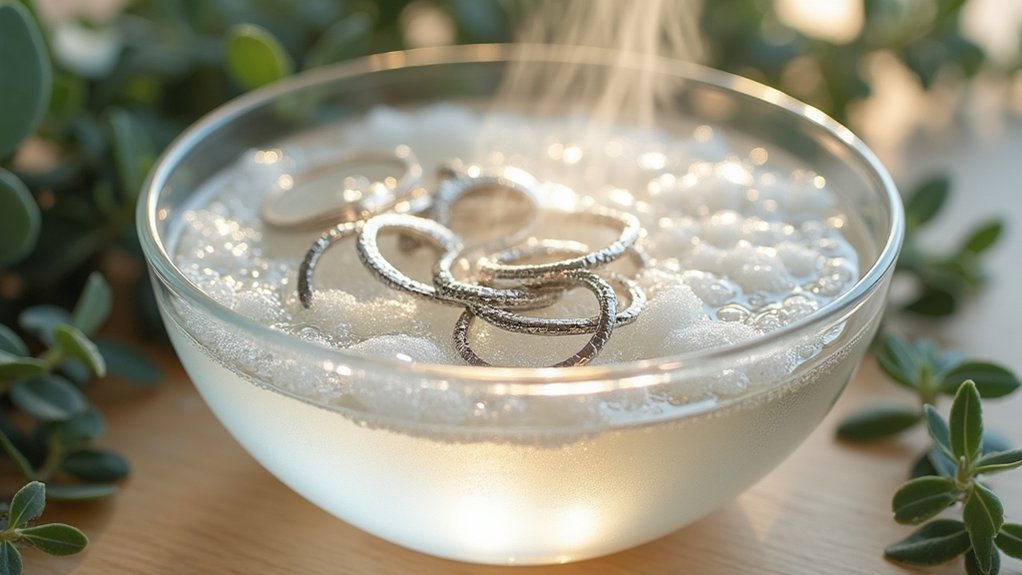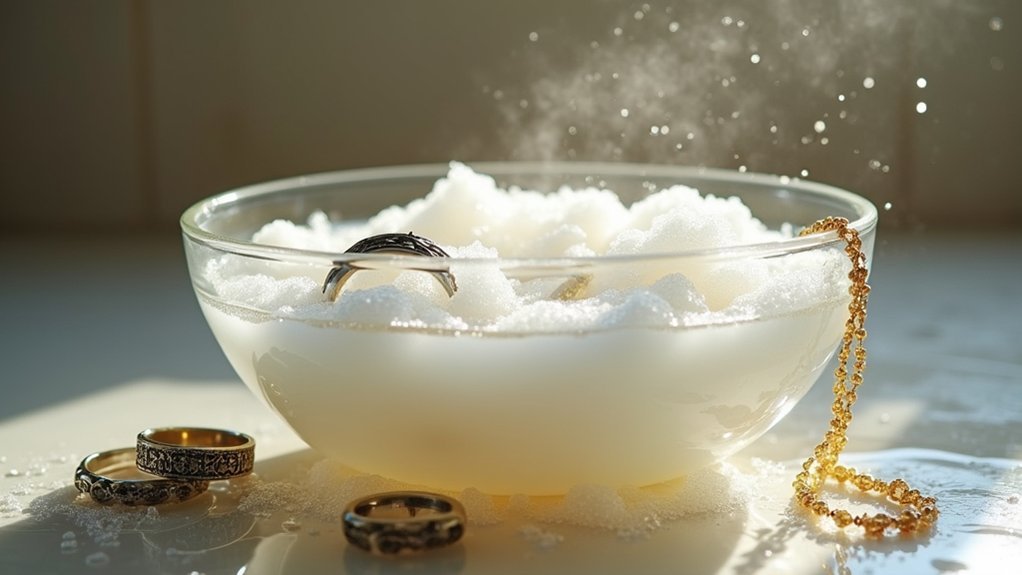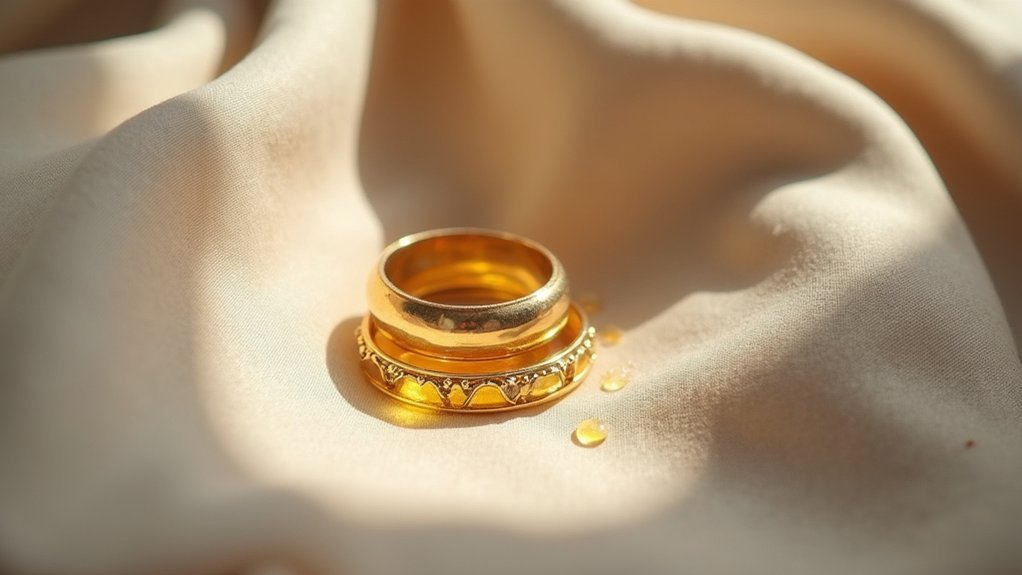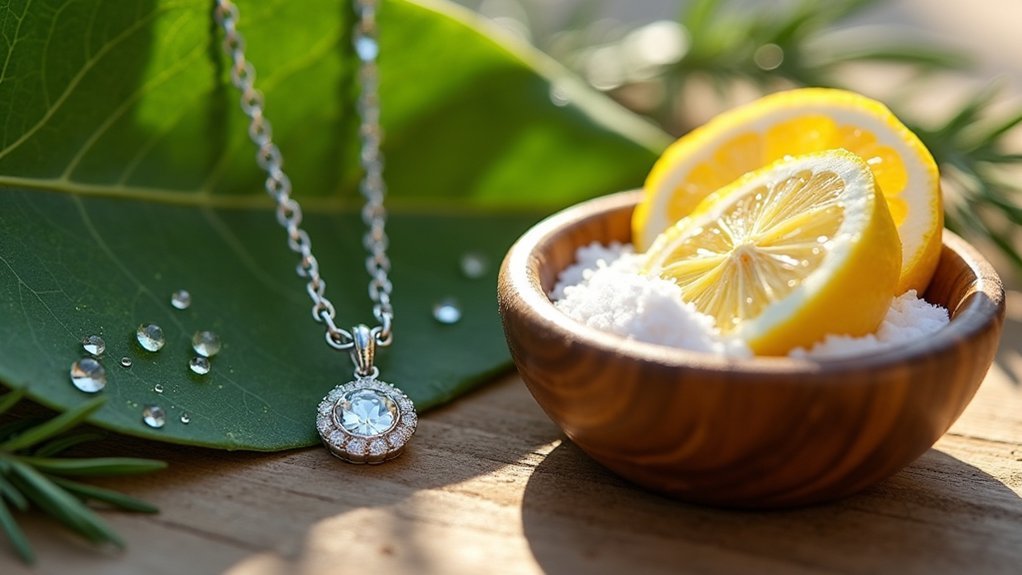You’re probably tossing jewelry cleaning products filled with harsh chemicals without realizing there’s a better way. Your favorite pieces don’t need expensive solutions or toxic substances to sparkle like new. Natural household items you already own can restore that brilliant shine while protecting both your jewelry and the environment. These five simple methods will transform your cleaning routine and save you money in ways you haven’t considered.
Bicarbonate of Soda and Hot Water Method

The bicarbonate of soda and hot water method harnesses a simple chemical reaction to restore your tarnished silver jewelry’s original shine without relying on harsh commercial cleaners.
Line a bowl with aluminum foil, add one tablespoon of baking soda, then pour boiling water over your jewelry. Let it soak for about an hour as the baking soda and aluminum create an eco-friendly cleaning reaction that lifts tarnish naturally.
After soaking, gently scrub stubborn spots with scrunched foil and wipe everything with a damp cloth to remove residue.
This method’s perfect when you want to clean your jewelry sustainably, though avoid using it on pieces containing soft stones like pearls or opals. You can also apply this technique to silver cutlery and candlesticks.
Aluminum Foil and Salt Solution Technique
While similar to the previous method, aluminum foil and salt solution technique offers a slightly different approach that many find even more effective for heavily tarnished pieces.
You’ll line a bowl with aluminum foil, place your tarnished silver jewelry inside, then cover everything with boiling water mixed with one tablespoon of baking soda. This creates a chemical reaction that transfers tarnish from your jewelry to the foil, eliminating the need for harsh cleaning products.
After soaking for about an hour, wipe your silver jewelry with a damp cloth to remove bicarbonate residue.
This technique works safely for most silver pieces but avoid using it on jewelry containing soft stones like pearls, opals, or lapis lazuli, as these materials can be damaged.
Mild Dish Soap and Warm Water Cleaning

Sometimes the gentlest approach proves most effective, and mild dish soap with warm water stands as the safest cleaning method for nearly all jewelry types. This sustainable approach uses eco-friendly dish soap free of harsh chemicals, making it perfect for delicate pieces.
| Step | Action |
|---|---|
| 1 | Mix eco-friendly dish soap with warm water |
| 2 | Scrub gently with soft cloth or brush |
| 3 | Focus on crevices where dirt accumulates |
| 4 | Rinse thoroughly with cool water |
| 5 | Dry completely with lint-free cloth |
You’ll find this cleaning technique works effectively on diamonds, silver, and pearls alike. The sustainable practices involved guarantee you’re protecting both your jewelry and the environment while achieving brilliant results without expensive commercial cleaners.
White Vinegar Soaking for Gold Jewelry
Gold jewelry responds exceptionally well to white vinegar’s natural acidic properties, making this method ideal when you’re dealing with stubborn tarnish or buildup.
White vinegar’s acidic nature makes it the perfect solution for dissolving tough tarnish and restoring your gold’s brilliance.
You’ll create a simple cleaning solution by mixing equal parts white vinegar and water, then soak your gold pieces for approximately 20 minutes. This gentle approach effectively lifts away accumulated grime without harsh chemicals.
Follow these essential steps to clean jewelry safely:
- Check that your pieces don’t contain soft or porous stones before soaking
- Mix equal parts white vinegar and water in a bowl
- Soak gold jewelry for exactly 20 minutes maximum
- Gently scrub with a soft toothbrush to remove stubborn residue
- Rinse thoroughly and dry completely with lint-free cloth
Always remove all vinegar residue to prevent dulling your gold’s natural shine.
Soft Cloth Polishing With Natural Oils

Two common household oils—olive and coconut—can transform dull jewelry into gleaming pieces when paired with proper polishing techniques.
You’ll need a clean, soft polishing cloth and a small amount of your chosen natural oil. Gently rub the oil onto your gold and silver jewelry using circular motions to remove tarnish and accumulated dirt while restoring brilliance.
These natural oils create a protective barrier that prevents future tarnishing, extending your jewelry’s lifespan considerably.
However, you should avoid using oils on porous stones like pearls or opals, as moisture can cause permanent damage.
Regular polishing with natural oils offers a sustainable cleaning method that maintains your jewelry’s appearance without harsh chemicals while providing long-term protection.
Frequently Asked Questions
What Is the Best Homemade Solution to Clean Jewelry?
You’ll find that mixing equal parts vinegar and water creates the most versatile homemade jewelry cleaner. It’s gentle enough for most metals and stones while effectively removing buildup without harsh chemicals.
How Do You Clean Jewelry Without Chemicals?
You can clean jewelry without chemicals by using mild dish soap with warm water, baking soda paste, white vinegar soaks, or aluminum foil reactions with baking soda for effective, natural cleaning.
Is Hydrogen Peroxide or Rubbing Alcohol Better for Cleaning Jewelry?
Rubbing alcohol’s better for regular jewelry cleaning since it’s gentler on most stones and metals. You’ll find hydrogen peroxide works well for deep cleaning, but it’s harsher and can damage certain gemstones.
Does Vinegar Clean Jewelry?
You can use vinegar to clean gold jewelry effectively by soaking it for twenty minutes, but don’t use it on gemstones or pearls since it’ll damage them.
In Summary
You’ve now got five powerful, natural methods to keep your jewelry sparkling without harming the environment. These techniques won’t just save you money—they’ll protect your precious pieces from harsh chemical damage while reducing your ecological footprint. Whether you’re dealing with stubborn tarnish or routine maintenance, these sustainable solutions will keep your jewelry looking brilliant. Start incorporating these eco-friendly practices today and you’ll notice the difference immediately.





Leave a Reply